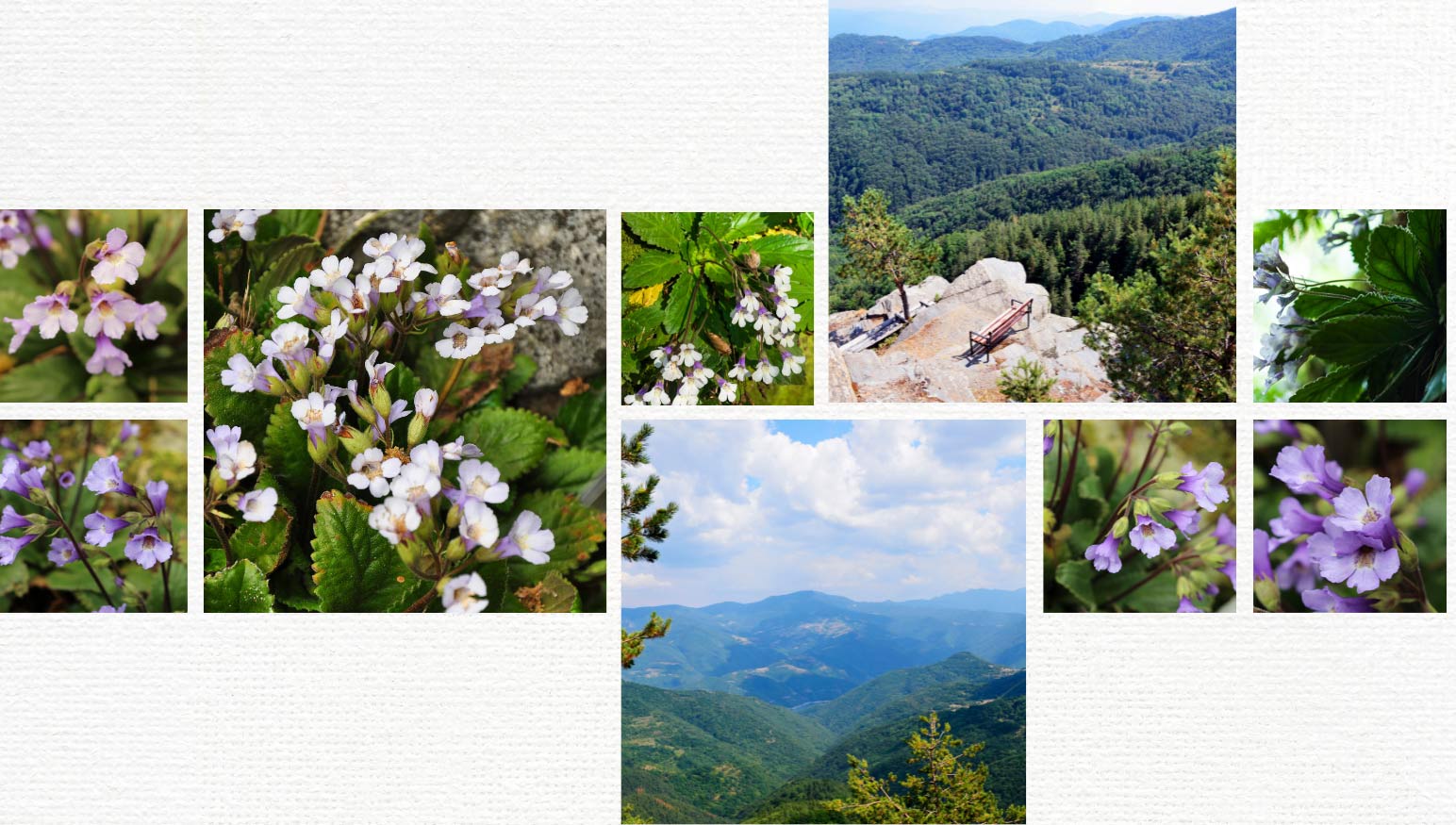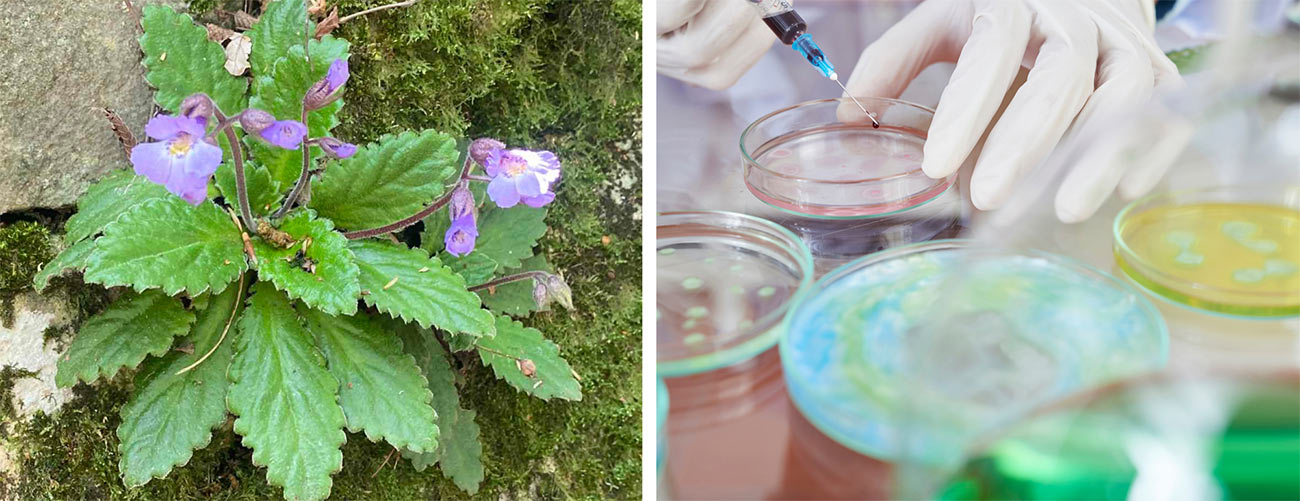Haberlea Rhodopensis and its Magical Healing Properties
The Sacred Scrolls of Haberlea
In today’s world, due to the busy daily life and the simultaneously fast-paced mental and sedentary physical lifestyle, individuals more than ever need a balance of both mental and physiological well-being that harmonizes with their internal sense of satisfaction and homeostasis of the body. All the challenges that individuals face on a daily basis inevitably leave a mark on their overall health and increase the levels of stress in the body. The chronic exposure to stress could lead to various pathological changes and conditions, ranging from loss of tonus to affecting fertility. Therefore, it is not surprising that there is a search for different approaches and methods to neutralize both the stress factors and the already generated oxidative stress in the body, aiming to achieve balance and preserve the quality of life despite the unfavorable and dynamically changing environment in which we are placed.
In this regard, over the past decade, various solutions have been developed and offered on the market in the form of dietary supplements to help maintain our bodies in good health and away from daily stress. That is why pharmacology has turned to the richest molecular library, the biologically active substances of plant origin, which exhibit both antioxidant and anti-inflammatory effects. One such plant with a range of beneficial effects is Haberlea Rhodopensis, also known as the Resurrection Plant and Rhodope Silivryak, which possesses a unique ability for drought resistance and belongs to the group of Balkan endemics.
Until now, the plant has been studied and described to exhibit antioxidant, radioprotective, antimicrobial, antimutagenic, anticancer, immunomodulatory, chemoprotective, and anti-aging effects. The main components in the extract of Haberlea are myconoside, ferulic acid, caffeic acid, syringic acid, luteolin, quercetin, hesperidin, and sinapic acid.
The biologically active substances in Haberlea Rhodopensis extract (HRE) prevent the formation of free radicals at the cellular level or neutralize them through interaction, increase the levels of cellular antioxidant enzymes, and enhance the activity of DNA repair mechanisms. According to several researchers, the antioxidant, antiradical, and antimicrobial activity of HRE can be explained by the presence of phenolic compounds (phenolic acids, flavonoids, and polyphenols) accumulated in high quantities in HR. HRE also demonstrates a better effect than retinoic acid and retinol in stimulating the antioxidant defense of the skin after peroxide-induced stress in normal human dermal fibroblasts, leading to increased collagen VI (+822%), collagen XVI (+928%), and elastin (+144%) when treated with HRE.
The free radical scavengers in Haberlea Rhodopensis also play a key role in radiation protection since radiation-induced cytotoxicity is mainly mediated by the generation of free radicals and their action on DNA in the biological system. According to a group of researchers, HR has radioprotective potential, as well as anticlastogenic, antimutagenic, antioxidant, and anti-aging effects due to the ability of its flavonoid aglycones, glycosides, and phenolic acids to capture free radicals and reduce oxidative stress. Membrane lipid damage is considered a critical factor inducing cell death and cell damage caused by radiation, while Haberlea rhodopensis extract reduces the products of lipid peroxidation induced by radiation, such as malondialdehyde, which damages DNA and enzymatic systems.
Another group of researchers discovered that the extract of Haberlea rhodopensis exhibits in vivo immunostimulatory activity, increasing the secondary production of IgG, IgM, and IgA in experimental rabbits immunized with keyhole limpet hemocyanin (KLH). The immunostimulatory effect persisted for more than 23 days after secondary application of HRE and KLH, revealing the immunostimulatory potential of HR to enhance humoral immune response.
The anticancer properties of HRE are largely attributed to its antioxidant effect, as demonstrated in a study conducted on cancer cells compared to normal cell lines, where it differentially modulated various cell lines under genotoxic and inflammatory stress, stimulating NFkB activation in p53+/+ cells while suppressing its signaling in p53-/- cells. This makes Haberlea rhodopensis a potential candidate for the treatment of prostate cancer.
The extract of Haberlea rhodopensis also exhibits a strong antioxidant and anti-ageing effect by inducing the genes for collagen and elastin in human skin through increased levels of mRNA due to the action of monoxide. HRE improves skin elasticity and has been proven in cosmetics for its anti-ageing effect.
References: Bankova, R. (2022). Haberlea rodopensis—Effects and potential applications. Tradit. Mod. Vet. Med, 7, 128-138. Dobreva, Z. G., B. N. Popov, S. Y. Georgieva, S. A. Stanilova. (2014). Immunostimulatory activities of Haberlea rhodopensis leaf extract on the specific antibody response: protective effects against γ-radiation induced immunosuppression. Food and Agricultural Immunology, 26 (3), 381–393. Dell’Acqua, G., K. Schweikert. (2011). Skin benefits of a monoxide-rich extract from resurrection plant Haberlea rhodopensis. International journal of cosmetic science. 34 (2):132–139. Georgieva, S., D. Gencheva, B. Popov, N. Grozeva, M. Zhelyazkova. (2019). Radioprotective action of resurrection plant Haberlea rhodopensis Friv. (Gesneriaceae) and the role of flavonoids and phenolic acids. Bulgarian Journal of Agricultural Science, 25 (3), 158–168. Hayrabedyan, S., K. Todorova, D. Zasheva, D. Moyankova, D. Georgieva, J. Todorova, D. Dji-lianov. (2013). Haberlea rhodopensis has potential as a new drug source based on its broad biological modalities. Biotechnol.& Biotechnol., 27 (1), 3553–3560. Hooda, R. (2015). Antiwrinkle herbal drugs – an update. Journal of Pharmacognosy and Phyto-chemistry, 4 (4), 277–281. Mihaylova D., A. Lante, A. Krastanov. (2014). Total phenolic content, antioxidant and antimicrobial activity of Haberlea rhodopensis extracts obtained by pressurized–liquid extraction. Acta Ali-mentaria. 44 (3), 326–332. Penchev, G., S. Georgieva, B. Popov. (2018). Protection against radiation–induced testicular injury in rabbits by Haberlea rhodopensis (a Balkan resurrection plant) extract. Bulgarian Journal of Veterinary Medicine, 21 (3), 313–321 Popov, B., S. Georgieva, V. Gadjeva, V. Petrov. (2011b). Radioprotective, anticlastogenic and antioxidant effects of total extract of Haberlea Rhodopensis on rabbit blood samples exposed to gamma radiation in vitro. Revue Méd. Vét., 162 (1), 34–39. Todorova, R. A. T. Atanasov. (2015). Haberlea rhodopensis: pharmaceutical and medical potential as a food additive. Natural Product Research 30 (5), 1–23.

Referencing Sources
“Preliminary Evaluation of Antibacterial Activity in Haberlea Rhodopensis Extracts: Effects on Staphylococcus Aureus and Gram-Negative Strains”
“Exploring the Multifaceted Potential of Haberlea Rhodopensis: Applications in Food Additives, Phytotherapy, and Cosmetics Based on Ethnobotanical Insights and Biological Activities”
Chemical Profiling, Antiproliferative and Antimigratory Capacity of Haberlea rhodopensis Extracts in an In Vitro Platform of Various Human Cancer Cell Lines
Haberlea Rhodopensis has Potential as a New Drug Source Based on its Broad Biological Modalities


